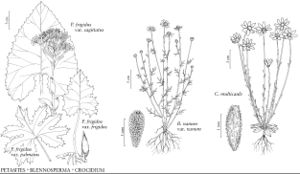Difference between revisions of "Petasites frigidus var. sagittatus"
Canad. J. Bot. 76: 2070. 1999.
FNA>Volume Importer |
FNA>Volume Importer |
||
| Line 64: | Line 64: | ||
|publication year=1999 | |publication year=1999 | ||
|special status= | |special status= | ||
| − | |source xml=https://jpend@bitbucket.org/aafc-mbb/fna-data-curation.git/src/ | + | |source xml=https://jpend@bitbucket.org/aafc-mbb/fna-data-curation.git/src/f50eec43f223ca0e34566be0b046453a0960e173/coarse_grained_fna_xml/V19-20-21/V20_1438.xml |
|tribe=Asteraceae tribe Senecioneae | |tribe=Asteraceae tribe Senecioneae | ||
|genus=Petasites | |genus=Petasites | ||
Revision as of 20:25, 16 December 2019
Basal leaves: blades palmately or palmati-pinnately nerved, sagittate or triangular to oblong, 2–34 × 2–30 cm (bases sagittate or cordate, sometimes hastate), margins not lobed (subentire, callous-denticulate, or sinuate-dentate, teeth 11–45 per side), abaxial faces densely woolly to villous, adaxial faces usually tomentose, sometimes glabrescent or glabrous. Staminate heads 8–35; ray florets 4–19, corolla laminae 1.1–7.7 mm; disc floret style branches 0.5–2.3 mm, hairy. Pistillate heads 6–34; ray florets 31–139, corolla laminae 0.6–5.4 mm; disc florets: corolla lobes 0.4–1.8 mm, style branches 0.3–1.3 mm, hairy. Pappi (pistillate) to 17.3 mm. 2n = 58, 59, 60.
Phenology: Flowering early spring.
Habitat: Wet places, shallow standing water or marshy areas, bogs, fens, moist disturbed areas, roadsides, alluvial flats, recent clearcuts, moist woods and forest edges
Elevation: 10–3000 m
Distribution

Alta., B.C., Man., N.B., Nfld. and Labr. (Labr.), N.W.T., Nunavut, Ont., Que., Sask., Yukon, Alaska, Colo. Idaho, Mich., Minn., Mont., N.Dak., S.Dak., Wash. Wis., Wyo.
Discussion
Selected References
None.
